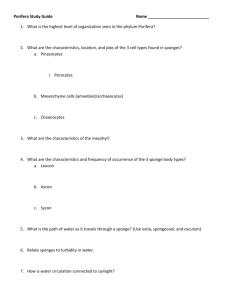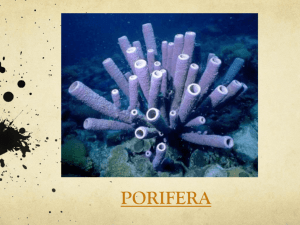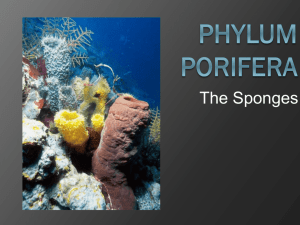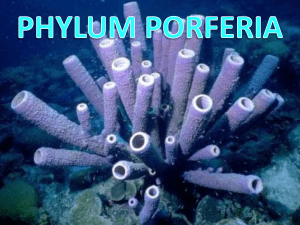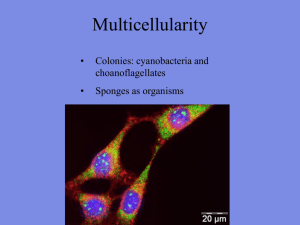FERGANA STATE UNIVERSITY FACULTY: NATIONAL
advertisement
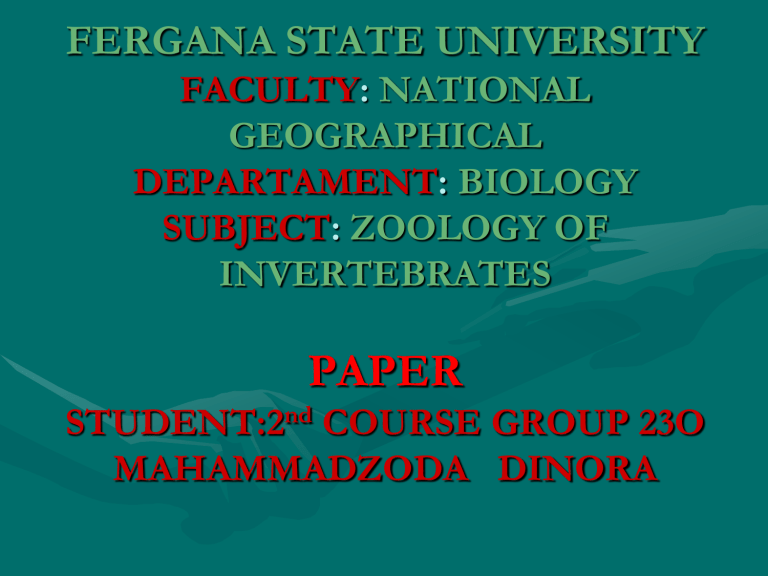
FERGANA STATE UNIVERSITY FACULTY: NATIONAL GEOGRAPHICAL DEPARTAMENT: BIOLOGY SUBJECT: ZOOLOGY OF INVERTEBRATES PAPER STUDENT:2nd COURSE GROUP 23O MAHAMMADZODA DINORA • Animals are multicellular, eukaryotic organisms of the kingdom Animalia or Metazoa. Their body plan eventually becomes fixed as they develop, although some undergo a process of metamorphosis later on in their lives. Most animals are motile, meaning they can move spontaneously and independently. All animals must ingest other organisms or their products for sustenance (see Heterotroph). • Most known animal phyla appeared in the fossil record as marine species during the Cambrian explosion, about 542 million years ago. Animals are divided into various sub-groups, including birds, mammals, amphibians, reptiles, fish and insects. • Etymology • The word "animal" comes from the Latin word animalis, meaning "having breath".[1] In everyday colloquial usage the word incorrectly excludes humans, instead it is often used to refer only to non-human members of the kingdom Animalia. Sometimes, only closer relatives of humans such as mammals and other vertebrates are meant in colloquial use.[2] The biological definition of the word refers to all members of the kingdom Animalia, encompassing creatures as diverse as sponges, jellyfish, insects, and humans.[3] Characteristics Animals have several characteristics that set them apart from other living things. Animals are eukaryotic and multicellular,[4] which separates them from bacteria and most protists. They are heterotrophic,[5] generally digesting food in an internal chamber, which separates them from plants and algae.[6] They are also distinguished from plants, algae, and fungi by lacking rigid cell walls.[7] All animals are motile,[8] if only at certain life stages. In most animals, embryos pass through a blastula stage,[9] which is a characteristic exclusive to animals. Predation is a biological interaction where a predator (a heterotroph that is hunting) feeds on its prey (the organism that is attacked).[29] Predators may or may not kill their prey prior to feeding on them, but the act of predation always results in the death of the prey.[30] The other main category of consumption is detritivory, the consumption of dead organic matter.[31] It can at times be difficult to separate the two feeding behaviours, for example, where parasitic species prey on a host organism and then lay their eggs on it for their offspring to feed on its decaying corpse. Selective pressures imposed on one another has led to an evolutionary arms race between prey and predator, resulting in various antipredator adaptations • Most animals indirectly use the energy of sunlight by eating plants or planteating animals. Most plants use light to convert inorganic molecules in their environment into carbohydrates, fats, proteins and other biomolecules, characteristically containing reduced carbon in the form of carbon-hydrogen bonds. Starting with carbon dioxide (CO2) and water (H2O), photosynthesis converts the energy of sunlight into chemical energy in the form of simple sugars (e.g., glucose), with the release of molecular oxygen. These sugars are then used as the building blocks for plant growth, including the production of other biomolecules.[10] When an animal eats plants (or eats other animals which have eaten plants), the reduced carbon compounds in the food become a source of energy and building materials for the animal.[33] They are either used directly to help the animal grow, or broken down, releasing stored solar energy, and giving the animal the energy required for motion.[34][35] 13 14 • Animals living close to hydrothermal vents and cold seeps on the ocean floor are not dependent on the energy of sunlight.[36] Instead chemosynthetic archaea and bacteria form the base of the food chain.[37] • Origin and fossil record • Further information: Urmetazoan 16 17 • Animals are generally considered to have evolved from a flagellated eukaryote.[39] Their closest known living relatives are the choanoflagellates, collared flagellates that have a morphology similar to the choanocytes of certain sponges.[40] Molecular studies place animals in a supergroup called the opisthokonts, which also include the choanoflagellates, fungi and a few small parasitic protists.[41] The name comes from the posterior location of the flagellum in motile cells, such as most animal spermatozoa, whereas other eukaryotes tend to have anterior flagella.[42] 19 • Orange elephant ear sponge, Agelas clathrodes, in foreground. Two corals in the background: a sea fan, Iciligorgia schrammi, and a sea rod, Plexaurella nutans. • The sponges (Porifera) were long thought to have diverged from other animals early.[54] They lack the complex organization found in most other phyla.[55] Their cells are differentiated, but in most cases not organized into distinct tissues.[56] Sponges typically feed by drawing in water through pores.[57] Archaeocyatha, which have fused skeletons, may represent sponges or a separate phylum.[58] However, a phylogenomic study in 2008 of 150 genes in 29 animals across 21 phyla revealed that it is the Ctenophora or comb jellies which are the basal lineage of animals, at least among those 21 phyla. The authors speculate that sponges—or at least those lines of sponges they investigated—are not so primitive, but may instead be secondarily simplified.[59] 21 • The remaining animals form a monophyletic group called the Bilateria. For the most part, they are bilaterally symmetric, and often have a specialized head with feeding and sensory organs. The body is triploblastic, i.e. all three germ layers are welldeveloped, and tissues form distinct organs. The digestive chamber has two openings, a mouth and an anus, and there is also an internal body cavity called a coelom or pseudocoelom. There are exceptions to each of these characteristics, however — for instance adult echinoderms are radially symmetric, and certain parasitic worms have extremely simplified body structures 23 • Genetic studies have considerably changed our understanding of the relationships within the Bilateria. Most appear to belong to two major lineages: the deuterostomes and the protostomes, the latter of which includes the Ecdysozoa, Platyzoa, and Lophotrochozoa. In addition, there are a few small groups of bilaterians with relatively similar structure that appear to have diverged before these major groups. These include the Acoelomorpha, Rhombozoa, and Orthonectida. The Myxozoa, single-celled parasites that were originally considered Protozoa, are now believed to have developed from the Medusozoa as well. 25 • The ecdysozoans also include the Nematoda or roundworms, perhaps the second largest animal phylum. Roundworms are typically microscopic, and occur in nearly every environment where there is water.[73] A number are important parasites.[74] Smaller phyla related to them are the Nematomorpha or horsehair worms, and the Kinorhyncha, Priapulida, and Loricifera. These groups have a reduced coelom, called a pseudocoelom. • The remaining two groups of protostomes are sometimes grouped together as the Spiralia, since in both embryos develop with spiral cleavage. 27 • Because of the great diversity found in animals, it is more economical for scientists to study a small number of chosen species so that connections can be drawn from their work and conclusions extrapolated about how animals function in general. Because they are easy to keep and breed, the fruit fly Drosophila melanogaster and the nematode Caenorhabditis elegans have long been the most intensively studied metazoan model organisms, and were among the first life-forms to be genetically sequenced. This was facilitated by the severely reduced state of their genomes, but as many genes, introns, and linkages lost, these ecdysozoans can teach us little about the origins of animals in general. The extent of this type of evolution within the superphylum will be revealed by the crustacean, annelid, and molluscan genome projects currently in progress. Analysis of the starlet sea anemone genome has emphasised the importance of sponges, placozoans, and choanoflagellates, also being sequenced, in explaining the arrival of 1500 ancestral genes unique to the Eumetazoa


